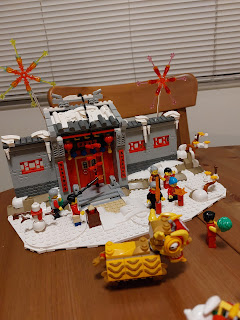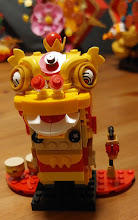2022 is the Year of the Water Tiger. What does that mean? The Chinese zodiac is based on 3 main elements: yin/yang, the five elements or wu xing, and the 12 zodiac animals. The zodiac rotates in a 60 year cycle to combine all the elements. How does this work?
The yin and yang are important in Chinese thought. They are seen as the ever-changing nature of the universe with active energy--yang (represented by the white in the symbol) below and passive energy--yin (represented by the black in that symbol). All nature is seen as passing through cycles of active yang energy followed by passive yin energy. This is similar to the interplay between sunlight and shadow, the cycle of day and night, male and female energies. These are not oppositional forces in Chinese thought; they are complementary. The Chinese divide the 12 zodiac animals into pairs and designate the first of the pair as yang and the second as yin.

The order of the animals is based on a tradition that Jade Emperor (or in some stories the Buddha) had the animals race to see who would be first. The Rat rode on the Ox until just before the finish line, when he leaped across to be the winner. The first pair of the Chinese Zodiac are the Rat (yang) and the Ox (yin). The rest of the animals are sequenced in the order that they placed in the race. The Boar is last because he stopped for a snack and again for a nap.
Here are the six pairs based on the 12 animals: Rat/Ox, Tiger (yang)/Rabbit (yin), Dragon/Snake, Horse/Goat, Monkey/Rooster, Dog/Boar.
The Five Elements are another concept of ancient Chinese thought. They represent phases in natural cycles, such as cycles of nature or human life cycles. They are also the building blocks of life. Each element in the cycle leads to the next, and if you put them in a circle the elements across from each other on the circle act in opposition to one another. In their order, they are Wood, Fire, Earth, Metal, and Water. Water causes trees to grow, and the cycle starts all over again with more Wood.
In the Chinese zodiac, each yin/yang pair of animals gets matched with one of the Five Elements at various times, as the Elements progress through their own cycle. These two cycles of 6 pairs of Zodiac animals times 5 elements creates the full 60-year Chinese Zodiac cycle.
2020 was the Year of the Metal Rat, and 2021 was the Year of the Metal Ox. It is time for a new element as we come to the Yang partner of the next pair. The next element in the cycle is Water. So we get a Water Tiger Year.
This year then has plenty of Yang energy, which will make it an active year. It also has plenty of Tiger energy. Tigers are brave, courageous, restless, loyal, and strong. They are the Kings of the Forest in Chinese mythology. Water is a symbol of change, which means that the year will be bring many changes. Water is also a symbol of wealth, which means that if people are strong and bold in 2022, they can change their monetary fortunes for the better. Most websites publishing Chinese horoscopes also warn that the activity of the Tiger combined with the changeableness of water mean that 2022 will be an exhausting year. We will need to pay attention to maintaining our health to keep up with all the good changes that the year can bring us.






















